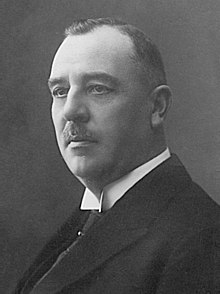Konstantin Konik
Konstantin Konik (born December 19 July / December 31, 1873 greg. In Tartu ; † August 3, 1936 ibid) was an Estonian politician and physician.
Early years
Konstantin Konik grew up in simple circumstances. After graduating from high school in Tartu, he studied medicine at the University of Tartu from 1893 to 1898 . The ambitious Konik joined the Student Estonian Association (Estonian Eesti Üliõpilaste Selts ) in his first year of study . From 1899 he was employed as a doctor in a sugar factory in western Ukraine , then in a hospital in Odessa . In 1904/05 he took part in the Russo-Japanese War as a medic.
Way into politics
In 1905 he returned to Tartu. There he became involved politically and socially under the impression of the Russian Revolution of 1905. He stood up for radical Estonian national ideas and against the tsarist tyranny. In 1908 he received his doctorate. med. at the University of Tartu .
In 1909 Konstantin Konik settled in Tallinn as a doctor. From 1913 to 1915 Konik was the editor of the magazine Tervis ("Health"). During the First World War he was the head of the city's health department.
Politician
In 1917 Konik was appointed a member of the Estonian provisional government and in November 1918 became head of the Ministry of Health. In the same year he founded the social democratically oriented Estonian Labor Party ( Eesti Tööerakond ) with politically like-minded people .
On February 19, 1918, the Council of Elders of the Provisional Landtag appointed Konik a member of the three-member Estonian Rescue Committee ( Eesti Pästekomitee ), which advocated the separation of Estonia from Russia and full state sovereignty. Together with Konstantin Päts and Jüri Vilms , Konik is one of the three founding fathers of the Republic of Estonia , who proclaimed the independent Republic of Estonia on February 24, 1918.
When imperial German troops marched into Tallinn on February 25, 1918, his political activities were severely curtailed. Konik was arrested in August of the same year for his national Estonian activities. Only with the collapse of the German Empire in November 1918 did he regain his freedom. From 1918 to 1920 he headed the health service of the young Estonian state. In 1919/20 he was a member of the Constituent Assembly of the Republic ( Asutav Kogu ), in which the Estonian Labor Party had thirty of the 120 MPs.
Mediciners
In the early 1920s, Konik withdrew from active politics. From September 1920 to 1931 Konstantin Konik was Professor of Surgery, Dean of the Medical Faculty of the University of Tartu and Head of the University's Neurological and Children's Clinic. On March 8, 1920, he held the first Estonian-language auditorium lecture at the university. The university hospital modernized itself under Konik's aegis.
Late years
In 1932 Konik was elected to the Estonian Parliament ( Riigikogu ) in Järva County as a member of the National Center Party ( Rahvuslik Keskerakond ), the successor to the Estonian Labor Party.
In 1933 Konik was briefly Minister for Education and Social Affairs in the cabinet of Prime Minister Jaan Tõnisson . Konik warned in particular of a looming war between Hitler and Germany and considered the League of Nations to be too weak to guarantee peace in Europe. In the autumn of 1933 Konik fell seriously ill. He died in Tartu in 1936.
Private life

Konstantin Konik's first marriage was to Matilde Pistrik, an employee of the Postimees newspaper . His wife died when he was 56 years old. He then married Viktoria, the divorced wife of the Estonian artist Nikolai Triik . Both marriages remained childless.
literature
- Konstantin Konik: Vaba maa . Edited by Küllo Arjakas and Hando Runnel . Tartu 2004
- Arne-Lembit Kööp: Konstantin Konik arst, kes seisis Eesti Vabariigi sünni juures . In: Hippokrates (March 2006), pp. 219–222
- Eesti elulood. Tallinn: Eesti entsüklopeediakirjastus 2000 (= Eesti Entsüklopeedia 14) ISBN 9985-70-064-3 , p. 175f.
Web links
- "Saaga Konstantin Konikust" (Küllo Arjakas)
- "Kes oli Konstantin Konik?" (Tartu Postimees, February 23, 2005)
Remarks
- ↑ Title: Praeguse aja kirurgia ülesandeid ("The tasks of surgery in the present time")
| personal data | |
|---|---|
| SURNAME | Konik, Constantine |
| BRIEF DESCRIPTION | Estonian medic and politician, member of the Riigikogu |
| DATE OF BIRTH | December 31, 1873 |
| PLACE OF BIRTH | Tartu , Estonia Governorate |
| DATE OF DEATH | August 3, 1936 |
| Place of death | Tartu , Republic of Estonia |
